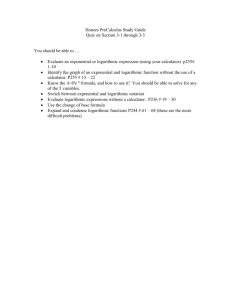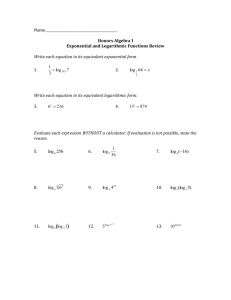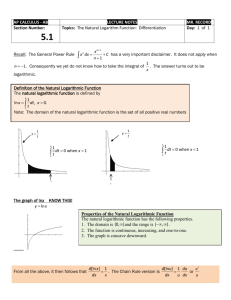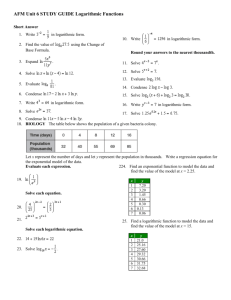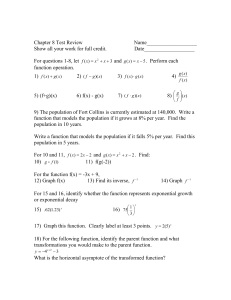Hindawi Publishing Corporation Journal of Applied Mathematics and Decision Sciences
advertisement
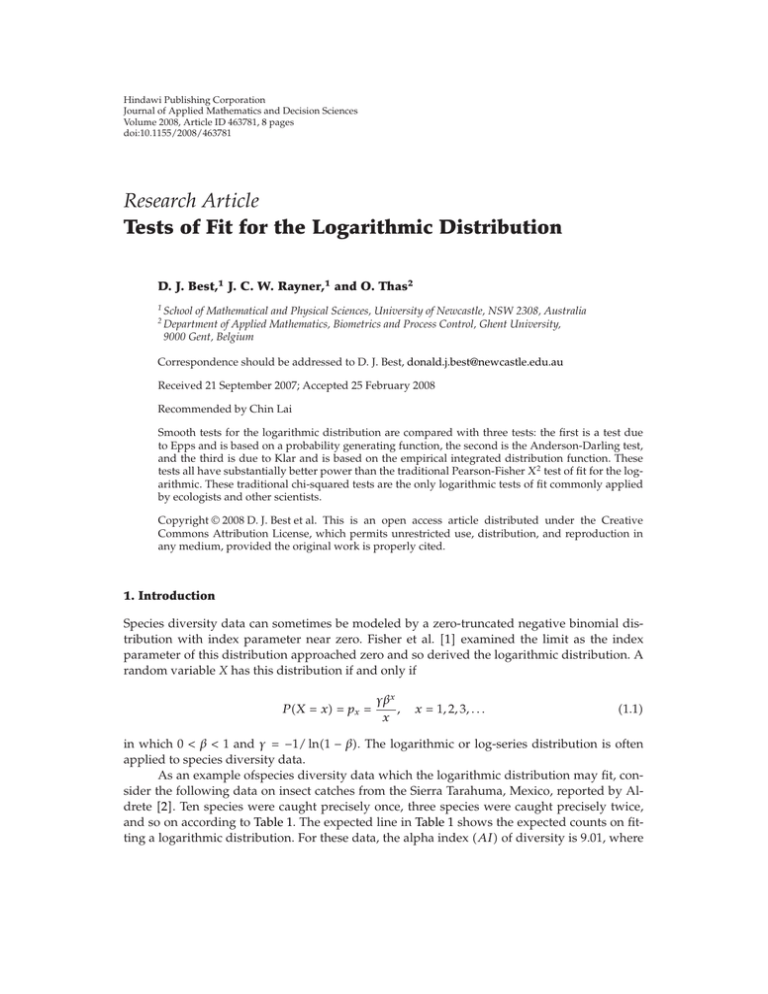
Hindawi Publishing Corporation
Journal of Applied Mathematics and Decision Sciences
Volume 2008, Article ID 463781, 8 pages
doi:10.1155/2008/463781
Research Article
Tests of Fit for the Logarithmic Distribution
D. J. Best,1 J. C. W. Rayner,1 and O. Thas2
1
2
School of Mathematical and Physical Sciences, University of Newcastle, NSW 2308, Australia
Department of Applied Mathematics, Biometrics and Process Control, Ghent University,
9000 Gent, Belgium
Correspondence should be addressed to D. J. Best, donald.j.best@newcastle.edu.au
Received 21 September 2007; Accepted 25 February 2008
Recommended by Chin Lai
Smooth tests for the logarithmic distribution are compared with three tests: the first is a test due
to Epps and is based on a probability generating function, the second is the Anderson-Darling test,
and the third is due to Klar and is based on the empirical integrated distribution function. These
tests all have substantially better power than the traditional Pearson-Fisher X 2 test of fit for the logarithmic. These traditional chi-squared tests are the only logarithmic tests of fit commonly applied
by ecologists and other scientists.
Copyright q 2008 D. J. Best et al. This is an open access article distributed under the Creative
Commons Attribution License, which permits unrestricted use, distribution, and reproduction in
any medium, provided the original work is properly cited.
1. Introduction
Species diversity data can sometimes be modeled by a zero-truncated negative binomial distribution with index parameter near zero. Fisher et al. 1 examined the limit as the index
parameter of this distribution approached zero and so derived the logarithmic distribution. A
random variable X has this distribution if and only if
P X x px γβx
,
x
x 1, 2, 3, . . .
1.1
in which 0 < β < 1 and γ −1/ ln1 − β. The logarithmic or log-series distribution is often
applied to species diversity data.
As an example ofspecies diversity data which the logarithmic distribution may fit, consider the following data on insect catches from the Sierra Tarahuma, Mexico, reported by Aldrete 2. Ten species were caught precisely once, three species were caught precisely twice,
and so on according to Table 1. The expected line in Table 1 shows the expected counts on fitting a logarithmic distribution. For these data, the alpha index AI of diversity is 9.01, where
2
Journal of Applied Mathematics and Decision Sciences
Table 1: Catch frequencies per species and corresponding expected values assuming a logarithmic model
for the Aldrete 2 data.
Times caught 1
2
3
4
5
6
8
10
11
12 13 16 25 69 95 At least 13
No. of species 10
3
4
2
2
2
1
1
1
1
1 1 2 1 1
6
Expected
8.78 4.28 2.78 2.03 1.58 1.28 1.07 0.91 0.62 0.55 — — — — —
7.63
Table 2: Oscar frequencies per film 1983 to 2000 and corresponding expected values assuming a logarithmic
model.
Oscars
No. of films
Expected
1
111
103
2
29
36
3
14
17
4
9
9
5
6
5
6
1
3
7
4
2
8
1
1
9
2
—
10
0
—
11
1
—
At least 9
3
2
β in which n is the total number of insects and β is the maximum likelihood
AI n1 − β/
estimator of β. The AI quoted here is defined in Krebs 3, 12.13; for a discussion of the index of
diversity see Krebs 3, Section 12.4.1. Note that larger AI implies more diversity while smaller
AI implies less.
It would seem sensible to test the data for consistency with the logarithmic distribution
before quoting an AI value. However, the only statistic that appears to be commonly used by
ecologists as a test of fit for the logarithmic distribution is the so-called chi-squared test, which,
as Krebs 3, Section 12.4.1 notes, may not always have good power.
“The goodness-of-fit of the logarithmic series . . . can be tested by the usual chi-squared
goodness-of-fit test . . . this means low power . . . . Thus in most cases the decision to use the
logarithmic series . . . must be made on ecological grounds, rather than statistical goodness-offit criteria.” 3, page 429.
In this paper, we will examine a number of statistical tests which are considerably more
powerful than the traditional Pearson-Fisher X 2 test. These include tests of fit based on components of Neyman’s smooth test statistic, the Anderson-Darling test discussed by Lockhart
et al. 4, an empirical integrated distribution function test given by Klar 5, and a test due to
Epps 6 based on a probability generating function pgf. We suggest that these could be used
to help make a decision as to whether or not to use the logarithmic series based on statistical as well as ecological criteria. In particular, the dispersion statistic, V2 , defined subsequently,
should be useful for identifying the not infrequent case of data for which the abundance species
are more abundant than predicted by the logarithmic series.
Our second example is included for its somewhat curious interest and is not involved
with conventional species diversity. Collins and Hand 7 have counted the number of times,
in the period 1983 to 2000, that a Hollywood film won one Oscar, two Oscars, three Oscars, and
so on, giving the data in Table 2. The film with 11 Oscars was “Titanic.”
2. Tests of fit for the logarithmic
A discussion of smooth tests of fit and their components, particularly when testing for the
logarithmic, is given in Appendix A. These tests may be derived as a routine application of
Rayner and Best 8, Theorem 6.1.1. The first-order component V1 is identically zero when β is
estimated by maximum likelihood, or, equivalently, by method of moments. The test based on
the component V2 suggests whether or not the data are consistent with the logarithmic variance
D. J. Best et al.
3
while the test based on V3 suggests whether or not the data are consistent with logarithmic
moments up to the third. To find p-values for these tests, it is suggested that the parametric
bootstrap is to be used as convergence to the asymptotic standard normal distribution is very
slow. See Gürtler and Henze 9 and Appendix B for details of the parametric bootstrap in a
goodness of fit context.
In Section 3, we give powers for the Anderson-Darling test based on the statistic
A2 Zj2 pj
j1 hj 1 − hj
∞
2.1
j
j
in which Zj x1 Ox − npx , hj x1 px , and Ox is the number of observations equal to x.
Summation is halted when x is the minimum such that Ox 0 and ∞
j < 10−3 /n. We also
jx p
give powers for a test given by Klar 5, based on the empirical integrated distribution function
with test statistic
k
√
2.2
Tn n sup Zj 1≤k≤M j1
in which M is the largest observation. Finally, for comparison purposes, we quote powers of
the pgf and X 2 tests given by Epps 6.
3. Power comparisons
Random deviates from the logarithmic L, positive Poisson P, and positive geometric G
distributions were generated using IMSL 10 routines RNLGR, RNPOI, and RNGEO. Random zeta deviates Z and random Yule deviates Y were found using algorithms of Devroye
11, pages 551 and 553. Table 3 gives powers for the same alternatives as used by Epps 6, but
with the addition of two Yule alternatives. For convenience, we reproduce the powers given by
Epps for his pgf and X 2 tests. The powers we give for A2 , Tn , V22 , V32 , and V22 V32 were found
using parametric bootstrap with 1000 simulations both for the inner and the outer loops. Note
that the calculation of V3 can involve large numbers, and calculation of the pgf and A2 statistics
can involve small numbers. Care with rounding error may be needed. The statistics Tn and V 2
2
are less prone to rounding error. Klar 5 notes that the smooth tests, the X 2 test, and the pgf
test are not consistent against all alternatives.
From Table 3 our powers for Tn are a little greater than those of Klar 5, and we observe
that the power for the Z1.0 alternative is 0.73, somewhat larger than the 0.40 reported by Klar
5. Also from Table 3, we see that the X 2 test is not generally competitive with the other tests.
The test based on V22 V32 performs reasonably well. The test based on the Tn statistic
has power a little less than that for the pgf- and A2 -based tests. An advantage of the test based
on Tn is that Klar 5 showed it is consistent.
The test based on the dispersion statistic V22 has good power for the zeta and Yule alternatives, while the A2 and pgf tests generally have competitive powers for all alternatives.
Clearly, the test based on V22 will not have good power for alternatives with similar dispersion
to the logarithmic distribution. If the test based on V 2 is not significant but that based on V 2
2
3
is, this suggests a skewness departure from the logarithmic distribution. However, if the test
4
Journal of Applied Mathematics and Decision Sciences
Table 3: Powers of some tests for the logarithmic distribution with n 50 and α 0.05.
Alternative
V22
V32
V22 V32
PGF
X2
Tn
A2
P 1.05
P 1.2
P 1.3
G 0.25
G 0.33
G 0.4
Z1.0
Z1.3
Z2.0
Y2.75
Y3.0
0.39
0.49
0.57
0.45
0.32
0.21
0.85
0.74
0.50
0.55
0.50
0.54
0.68
0.78
0.07
0.37
0.39
0.37
0.63
0.38
0.38
0.35
0.51
0.63
0.69
0.05
0.30
0.33
0.54
0.72
0.43
0.50
0.45
0.56
0.72
0.79
0.78
0.61
0.46
0.84
0.72
0.44
—
—
0.43
0.58
0.63
0.51
0.39
0.30
0.08
0.16
0.17
—
—
0.50
0.61
0.68
0.52
0.38
0.30
0.73
0.68
0.48
0.49
0.46
0.57
0.73
0.79
0.77
0.58
0.48
0.72
0.69
0.42
0.43
0.35
based on V22 is significant, then this suggests that the test based on V32 may be significant due
to either a dispersion or a skewness departure of the data from the logarithmic distribution.
Notice that we say the test based on V32 suggests how the data deviate from the logarithmic.
We do not claim that the data actually do deviate in this manner. See the comments of Henze
and Klar 12.
On the basis of Table 3 powers, we suggest that the tests based on A2 and Klar’s Tn are
considered as tests of fit for the logarithmic distribution. These tests have good power and are
consistent. We recommend that the tests based on Tn and A2 are augmented by the use of V22
and V32 in a data analytic fashion.
4. Examples
In the following parametric bootstrap, p-values for the tests based on V22 , V32 , A2 , and Tn are
given. These use 1000 random samples of the logarithmic distribution with parameter β as
given below. We give V2 and V3 values because they may suggest how the data deviate from
the logarithmic. We give the A2 and Tn values because the tests based on these statistics are
consistent and have good power.
4.1. Insect data
From the data in Table 1, we find β 0.9743, AI 9.0104, V2 0.4879 with p-value 0.52,
V3 −0.8791 with p-value 0.19, A2 0.2613 with p-value 0.82, and Tn 204.8192 with
p-value 0.33. It appears that the logarithmic distribution is a good fit. In agreement with this,
the Pearson-Fisher statistic takes the value 4.56 on 11 degrees of freedom when data greater
than 12 have been combined.
4.2. Oscars data
We find that V2 0.49, V3 −1.27, and X 2 7.40 on 7 degrees of freedom if the classes greater
than or equal to 9 are combined. The corresponding p-values are 0.58, 0.08, and 0.62. It appears
D. J. Best et al.
5
that a logarithmic distribution with β 0.7044 fits the data reasonably well.However, the pvalue for V3 suggests that the data may not be quite as skewed as would be expected for the
logarithmic distribution. Collins and Hand 7 suggest a Yule distribution fits the data well. In
addition, we note that A2 0.9727 with p-value 0.12 and Tn 120.0203 with p-value 0.26.
5. Conclusion
In this paper, we have examined a number of statistical tests which are considerably more
powerful than the traditional Pearson-Fisher X 2 test. We suggest that these could be used to
help make a decision as to whether or not to use the logarithmic series based on statistical as
well as ecological criteria. A test of fit could be done before quoting the index of diversity. In
particular, the dispersion statistic, V2 , should be useful for identifying the not infrequent case
of data for which the abundance species are more abundant than predicted by the logarithmic
series.
Appendices
A. The smooth tests and their components
For distributions from exponential families the smooth tests can be derived as score statistics
for testing H0 : θ 0 against K : θ /
0 for observations X1 , . . . , Xn from the model
Cθ, β exp
qk
θi gi x; β fx; β
A.1
iq1
in which
i fx; β is a probability density function that depends on a q × 1 vector of nuisance
parameters β and for which we test;
ii {gi x; β} is a complete orthonormal set on fx; β;
iii Cθ; β is a normalizing constant.
For details see Rayner and Best 8.
The score test statistic has a particularly appealing form
2
2
· · · Vqk
,
Sk Vq1
A.2
where
n
1 gr xj ; β ,
Vr √
n j1
r q 1, . . . , q k.
A.3
Here, β is the maximum likelihood estimator of β assuming that H0 is true.
To define Vr , central moments of fx; β up to order 2r are required. For example, to
directly define components up to V3 to test for the logarithmic, we note that the equation to
6
Journal of Applied Mathematics and Decision Sciences
estimate β is V1 ≡ 0, as discussed below. To define V2 and V3 requires g2 x; β and g3 x; β,
which in turn require central logarithmic moments up to order six. These are given by
μ
μ2 μ3 μ4 γβ
,
1 − β
γβ1 − γβ
,
1 − β2
γβ 1 β − 3γβ 2γ 2 β2
1 − β3
γβ 1 4β − 4γβ β2 − 4γβ2 6γ 2 β2 − 3γ 3 β3
1 − β
μ5 ,
4
A.4
,
γβ 1 11β 11β − 5γβ − 20γβ2 10γ 2 β2 β3 − 5γβ3 10γ 2 β3 − 10γ 3 β3 4γ 4 β4
2
1 − β5
,
μ 6 γβ 1 26β − 6γβ 66β2 − 66γβ2 15γ 2 β2 26β3 − 66γβ3 60γ 2 β3 − 20γ 3 β3 β4
− 6γβ4 15γ 2 β4 − 20γ 3 β4 15γ 4 β4 − 5γ 5 β5 /1 − β6 .
To calculate further orthonormal polynomials directly, we could use the result that for the
logarithmic, kr1 β∂kr /∂β generates cumulants and hence central moments, but it is more
efficient to use recurrence as described in Rayner et al. 13. Proceeding directly, the first six
central moments can be used to calculate
x − μ
,
√
μ2
x − μ2 − μ3 x − μ/μ2 − μ2
g2 x; β ,
μ4 − μ23 /μ2 − μ22
g1 x; β g3 x; β in which
A.5
x − μ3 − ax − μ2 − bx − μ − c
μ6 − 2aμ5 a2 − 2b μ4 2ab − cμ3 b2 2ac μ2 c2
μ5 − μ3 μ4 /μ2 − μ2 μ3
a
,
d
2
μ4 /μ2 − μ2 μ4 − μ3 μ5 /μ2 μ23
b
,
d
2μ3 μ4 − μ33 /μ2 − μ2 μ5
,
c
d
d μ4 −
A.6
μ23
− μ22 .
μ2
These formulas give the first three orthonormal polynomials for any univariate distribution.
D. J. Best et al.
7
The components Vr can be called smooth components as they are analogous to the components of the smooth test for uniformity introduced by Neyman 14. His smooth components
also used orthonormal polynomials. When testing for distributions from exponential families
these components are asymptotically independent and asymptotically have the standard normal distribution.
For the logarithmic distribution, the maximum likelihood and method of moments estimators β of β coincide, given by V1 ≡ 0 or
γ
β
β
.
X −
μ
1 − β ln 1 − β
1 − β
A.7
To solve this equation, the Newton-Raphson algorithm can be used. An initial estimate of β
and other details helpful in the solution are given in Birch 15. Note also that for the logarith
mic, V2 is proportional to m2 − μ
2 where m2 nj1 xj − x2 /n, so the test based on V2 tests
for the dispersion of the logarithmic distribution. Similarly, if m3 nj1 xj − x3 /n, then the
numerator of V3 is of the form nm3 − am2 − c, so the test based on V3 assesses whether the
data are consistent with moments of the logarithmic up to the third.
B. P-values via the parametric bootstrap
Gürtler and Henze 9, page 223 suggest that p-values can be obtained using an analogue of
the parametric bootstrap. If Wn denotes a test statistic, calculate wn : Wn x1 , x2 , . . . , xn where
x1 , x2 , . . . , xn denote, as usual, the data. Find an estimate β from the data and conditional on
this estimate, generate B 10 000 say pseudorandom samples of size n, each having the loga distribution. For j 1, . . . , B compute the value W ∗ on each random sample. The
rithmic β
n,j
∗
parametric bootstrap p-value is then the proportion of the Wn,j
that are at least the observed
B
∗
wn , namely, j1 IWn,j ≥ wn /B.
The above requires random logarithmic β values. Devroye 11, page 547 outlines an
algorithm for generating random logarithmic deviates. Alternatively, the routine RNLGR from
IMSL 10 can be used. To obtain p-values for two-tailed tests proceed as above and find the
p-value, say P. Then if P ≤ 0.5, the two-tailed p-value is 2P, while if P > 0.5, the two-tailed
p-value is 21 − P .
Acknowledgment
Research of Olivier Thas was supported by IAP research network Grant no. P6/03 of the Belgian Government Belgian Science Policy.
References
1 R. A. Fisher, A. S. Corbet, and C. B. Williams, “The relation between the number of species and the
number of individuals in a random sample of an animal population,” Journal of Animal Ecology, vol. 12,
no. 1, pp. 42–58, 1943.
2 A. N. G. Aldrete, “Psocoptera insecta from the Sierra tarahumara, Chihuahua, Mexico,” Anales del
Instituto de Biologı́a, Universidad Nacional Autónoma de México, Serie Zoologı́a, vol. 73, no. 2, pp. 145–156,
2002.
8
Journal of Applied Mathematics and Decision Sciences
3 C. J. Krebs, Ecological Methodology, Addison Wesley Longman, New York, NY, USA, 1998.
4 R. A. Lockhart, J. J. Spinelli, and M. A. Stephens, “Cramér-von Mises statistics for discrete distributions
with unknown parameters,” Canadian Journal of Statistics, vol. 35, no. 1, pp. 125–133, 2007.
5 B. Klar, “Goodness-of-fit tests for discrete models based on the integrated distribution function,”
Metrika, vol. 49, no. 1, pp. 53–69, 1999.
6 T. W. Epps, “A test of fit for lattice distributions,” Communications in Statistics: Theory and Methods,
vol. 24, no. 6, pp. 1455–1479, 1995.
7 A. Collins and C. Hand, “Vote clustering in tournaments: what can Oscar tell us?” Creativity Research
Journal, vol. 18, no. 4, pp. 427–434, 2006.
8 J. C. W. Rayner and D. J. Best, Smooth Tests of Goodness of Fit, The Clarendon Press, Oxford University
Press, New York, NY, USA, 1989.
9 N. Gürtler and N. Henze, “Recent and classical goodness-of-fit tests for the Poisson distribution,”
Journal of Statistical Planning and Inference, vol. 90, no. 2, pp. 207–225, 2000.
10 IMSL, Users’ Manual, IMSL, Houston, Tex, USA, 1995.
11 L. Devroye, Non-Uniform Random Variate Generation, Springer, New York, NY, USA, 1986.
12 N. Henze and B. Klar, “Properly rescaled components of smooth tests of fit are diagnostic,” Australian
& New Zealand Journal of Statistics, vol. 38, no. 1, pp. 61–74, 1996.
13 J. C. W. Rayner, O. Thas, and B. De Boeck, “A generalised Emerson recurrence relation,” to appear in
Australian & New Zealand Journal of Statistics .
14 J. Neyman, ““Smooth test” for goodness of fit,” Skandinavisk Aktuarietidskrift, vol. 20, pp. 149–199,
1937.
15 M. W. Birch, “194 Note: an algorithm for the logarithmic series distribution,” Biometrics, vol. 19, no. 4,
pp. 651–652, 1963.


